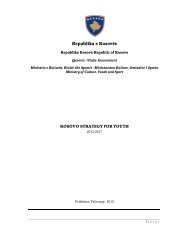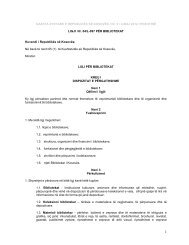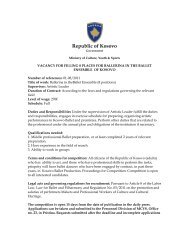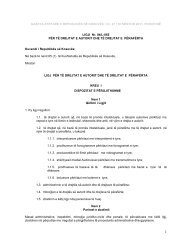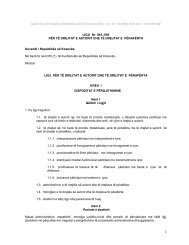Archaeological Guide of Kosovo
Archaeological Guide of Kosovo
Archaeological Guide of Kosovo
You also want an ePaper? Increase the reach of your titles
YUMPU automatically turns print PDFs into web optimized ePapers that Google loves.
The Late Antique Period and<br />
Medieval Period<br />
The Late Antique Period, respectively kwon also as the Early<br />
Byzantine Period, in <strong>Kosovo</strong> marks the time frame from the rule<br />
<strong>of</strong> the Emperor Constantine the Great (306-337 AD), respectively<br />
during the 4th, 5th and 6th century AD; a time period which was<br />
perceived by historians to describe the transitory phase from antiquity<br />
to medieval. One <strong>of</strong> the most distinguished features <strong>of</strong> the<br />
‘Late Antiquity’ was the centralization <strong>of</strong> power into the emperors<br />
hands, division <strong>of</strong> the military from civil administration, but on top<br />
<strong>of</strong> that, this period is related with the crises in ancient production<br />
system and with a decline <strong>of</strong> the Roman Empire. Nonetheless, besides<br />
the inner crises, the empire was confronted also with barbarian<br />
invasions. In regard to this period that is entwisted between innovations<br />
and tradition, the present day territory <strong>of</strong> <strong>Kosovo</strong>, which<br />
used to be the central part <strong>of</strong> the ancient Dardania, passes through<br />
some changes, transformations and developments in economical,<br />
social, cultural, religious and political-administrative aspect, which<br />
made an impact on future evolution <strong>of</strong> this area. Furthermore, the<br />
novelty <strong>of</strong> this epoch was the consolidation <strong>of</strong> the Christianity and<br />
the bloom <strong>of</strong> the Christian art and architecture, a characteristic for<br />
combination <strong>of</strong> tradition and innovation. Therefore, the construction<br />
architecture <strong>of</strong> this time is known by archaeologists, architects<br />
and art historians as the early Christian period architecture. On<br />
the other hand, the ancient written sources, archived church written<br />
sources, but even the oral histories in the form <strong>of</strong> myths, legends<br />
or local toponomy <strong>of</strong> the archaeology site locations, stored in the<br />
collective memory <strong>of</strong> the different parts <strong>of</strong> the <strong>Kosovo</strong> inhabitancy,<br />
have <strong>of</strong>fered and will provide very important data that is used in<br />
synthesised form to provide a general overview <strong>of</strong> either common<br />
or individual extraordinary rich archaeological heritage, not only<br />
<strong>Archaeological</strong> <strong>Guide</strong> <strong>of</strong> <strong>Kosovo</strong> 77




